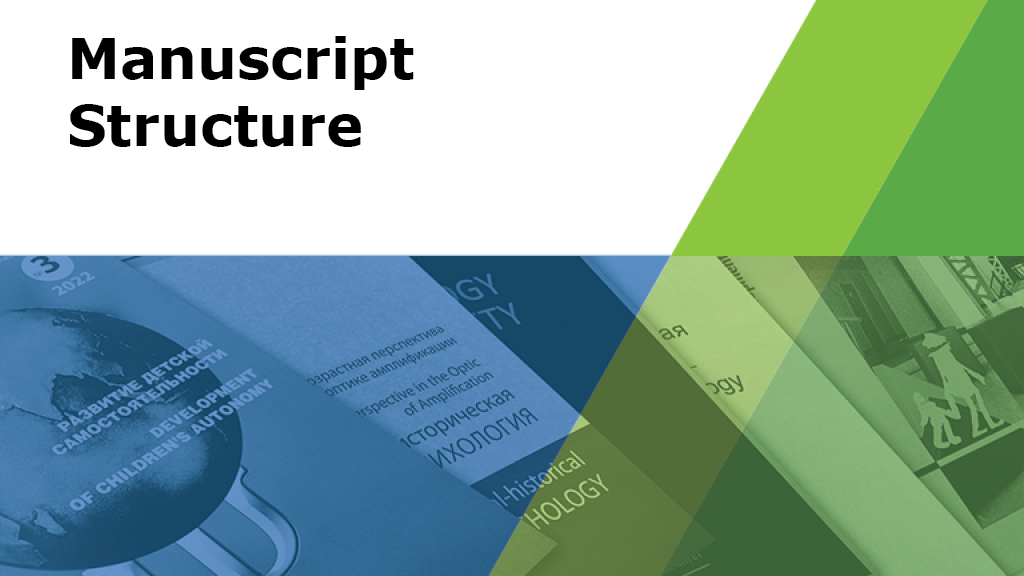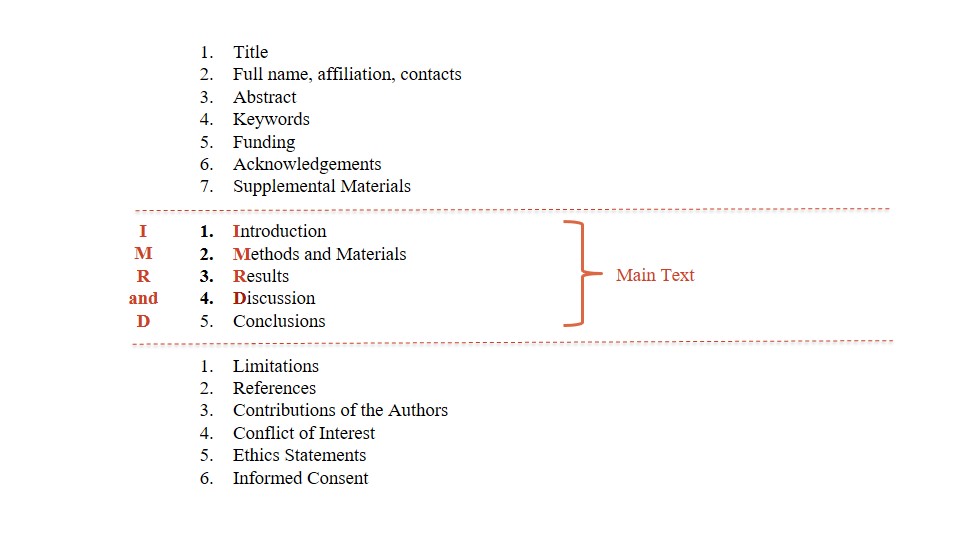The structure of the manuscript should comply with the genre of scientific texts and international standards for presenting the results of original scientific research (Tikhonova et al., 2023). The main genres of scientific texts in MSUPE journals include empirical articles (including case analysis), theoretical articles, methodological articles, and review articles (Raitskaya & Tikhonova, 2019) (see Table 2).
For manuscripts on original scientific research, the publisher follows the IMRaD structure for the main body of the text (see Figure 1). According to this structure, the main part of the article must contain the following sections:
- I — Introduction;
- M — Materials and Methods;
- R — Results;
- A — and;
- D — Discussion, followed by Conclusions. In the case of theoretical research, the Materials and Methods section is replaced by the Theoretical Basis section (GOST R 7.0.7-2021, 2021; Kirillova, 2018; Kulkarni et al., 2018).
Figure 1. Structural components of a scientific article prepared according to the IMRaD structure, with metadata and other required manuscript sections.
Table 2.
Description of the contents of manuscript sections according to their genre:
|
Section Title |
Empirical Article |
Theoretical Article |
Methodological Article |
Review Article |
|
Specifics of the Manuscript |
Results of original research |
Introduction or clarification of theoretical constructs; presentation of a new theory or its principles; critical analysis of existing theories; comparison of multiple theories |
Description of a new methodological approch; modification of an existing method; description of new methods, techniques, tools |
Analysis, synthesis, and critical evaluation of published research; systematisation and summarisation of known scientific data on a process, phenomenon, or object, on the basis of which new conclusions and forecasts are made |
|
Title |
The maximum length of the manuscript title should be 10–12 words. The title should be concise and informative, containing the main keywords that characterise the topic of the work, without the use of abbreviations or formulas. It is recommended to use three main types of titles: nominal (a descriptive phrase identifying the subject of research); compound (two nominal parts separated by a colon); or a full sentence (a problem question). |
|||
|
Author Information |
Authors of the manuscript are those who have made a significant contribution to the research, are responsible for the manuscript content, and have participated in its preparation. The order of co-authors depends on their contribution to the work, with the primary author being listed first. In the case of equal contribution, authors are listed alphabetically. The corresponding author is marked with an asterisk (*). The primary author’s information includes: initials and surname, affiliation (institution name), city, and country. For formatting, see section 5.4: Author Information. |
|||
|
Corresponding Author |
The details of the corresponding author, to whom queries can be addressed, should be listed after the asterisk (*) and must include their email address. |
|||
|
Abstract |
The abstract should be between 150 and 250 words (1200 to 2000 characters including spaces). Technical terms (e.g., section headings) are not included in the word count, which should amount to 10 words (81 characters with spaces). The abstract should follow the structure of the manuscript and for original research, it should be written according to the IMRaD format, with appropriate headings included. The abstract must not include references to sources from the full text or abbreviations that are only explained in the main text. Abbreviations and acronyms must be spelled out.
|
|||
|
Keywords |
Keywords form the semantic core of the manuscript and include the key concepts, terms, and important figures related to the issue being studied. Keywords serve as search terms in databases. There should be between five and ten keywords, with each phrase consisting of no more than three words. Jargon, neologisms, phrases with coordinated members, or abbreviations not explained in the abstract are not acceptable. Keywords should be ordered from general to specific. It is preferable to use keywords commonly found in publications on the same topic. Keywords in English should also be matched with those used in English-language publications on the topic of the manuscript. For MSUPE publications, keywords can be checked for consistency with those already published on the PsyJournals.ru portal. For formatting, see section 5.6: Keywords. |
|||
|
Funding |
Acknowledgement of funding sources: the name of the sponsoring organisation and, if applicable, the project/grant/programme number, or government task number, that supported the research. For formatting, see section 5.7: Funding Information. |
|||
|
Acknowledgements |
Acknowledgements of individuals and organisations. For formatting, see section 5.8: Acknowledgements. |
|||
|
Supplemental Data |
A statement regarding the availability of data, including information on where data supporting the results of the published article can be found, such as hyperlinks to publicly available datasets that were analysed or compiled during the research. Publicly available datasets mentioned in the data availability statement should also be cited in the manuscript’s reference list. For formatting, see section 2.6.1: Data Availability. |
|||
|
Introduction |
Problem statement; historical background; relevance; novelty; current state of the problem; aims; research objectives; hypotheses/questions. |
|||
|
Materials and Methods |
Research design, including programme/procedures and study phases; description of the sample; description of methods, techniques, materials, and equipment. Statistical procedures, if applicable, should be briefly outlined, as most use well-known methods. |
|||
|
Results |
Theoretical basis (if necessary). The empirical results of the research (text, tables, figures, graphs, photographs). |
Theoretical positions, both existing and/ or new, can be introduced. Empirical data are included when they are relevant to resolving the theoretical problem posed in the manuscript. |
Methodology should b e described in sufficient detail. Empirical data can be used to illustrate methodological positions. |
Review articles should synthesise information on the topic using methods such as summarisation, classification, analysis, or comparison. The main types of reviews are: Literature Review: Fact - based description of the current state of the problem based on published research. Systematic Review: Analysis of research based on predefined criteria. Meta-analysis: Systematisation of quantitative data to test a hypothesis proposed by the author. |
|
Discussion of Results |
Interpretation of the research findings; alignment with the research hypotheses or answers to research questions; summarising and explaining the results (Tikhonova, 2024). |
|||
|
Conclusion |
The main outcomes of the article, including key findings. It is advisable to compare the results with those initially expected and highlight their novelty and practical significance. Conclusions and recommendations should be listed and specific. Future research directions should be determined. It is recommended that conclusions be numbered and formulated as specifically as possible. |
|||
|
Limitations |
Possible limitations in generalising the results (e.g., sample size, limited data access). |
|||
|
References |
The reference list should include at least: |
|||
|
15 sources for empirical articles, |
20 sources for theoretical articles, |
20 sources for methodological articles, |
25 sources for review articles. |
|
|
It is recommended not to exceed the minimum number of sources by more than twice. For formatting, see section 5.13: Formatting the Reference List and Citations. |
||||
|
Full Author Information |
Full author details should be provided after the reference list at the end of the manuscript: Full name, academic degree, position, affiliation, city, country, ORCID, and email address. ORCID details are mandatory. To obtain or verify an ID, visit https://orcid.org/. It is recommended that the ORCID profile contain open information sufficient for author identification and a list of publications (if available). Multiple institutional affiliations may be listed, and abbreviations should not be used. All author information should be in nominative case. For formatting, see section 5.4: Author Information. |
|||
|
Authors’ Contributions |
Author contributions should be indicated after the “Full Author Information” section. The personal contribution of each author to the manuscript should be specified, covering areas such as conceptualisation, data collection, analysis, writing, scientific editing, and data visualisation. Authors may contribute in multiple roles. For formatting, see section 5.14: Authors’ Contributions. |
|||
|
Conflict of Interest |
Any competing and/or conflicting interests, such as personal relationships or academic competition, should be disclosed. If there is no conflict of interest, the following should be stated: “The authors declare no conflict of interest.” For formatting, see section 5.15: Conflict of Interest. |
|||
|
Ethics Statement |
The ethics statement should include confirmation of compliance with ethical standards (or a reasoned explanation if such a statement is unnecessary), the name of the ethics committee or institutional review board, the registration number/identifier of the approval, and confirmation that participants (or their legal representatives) provided informed consent prior to participating in the study. The statement format should be: “The study was reviewed and approved by the Ethics Committee [name of institution] [approval number, date].” For formatting, see section 5.16: Ethics Statement. |
|||
← Previous | Contents | Next →

